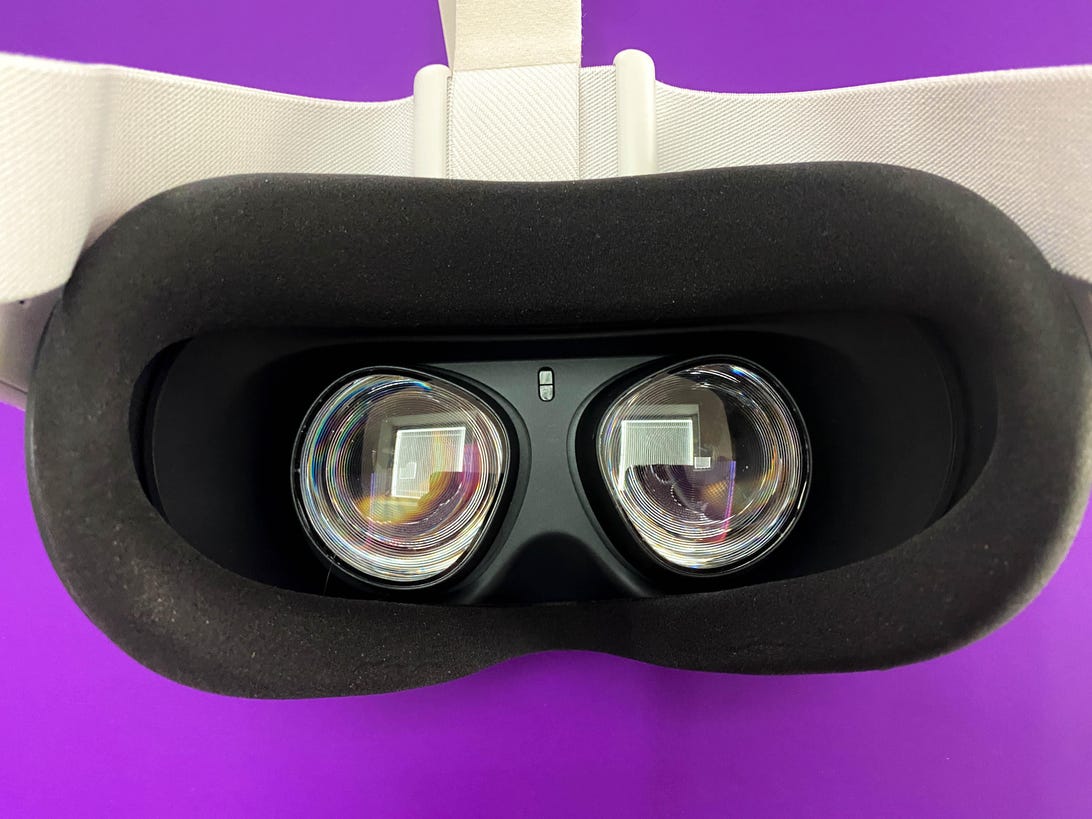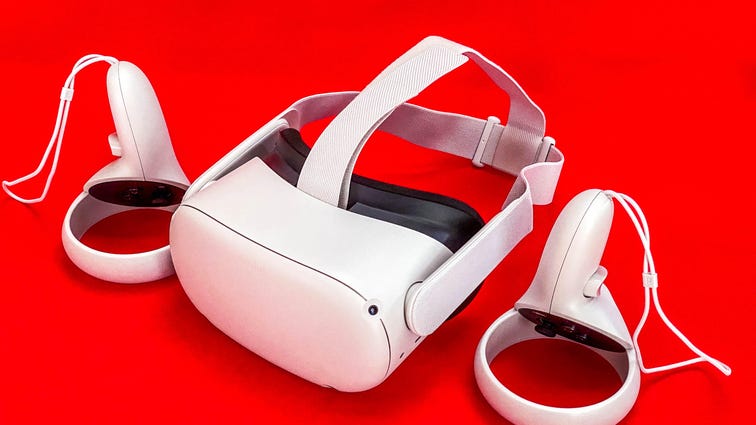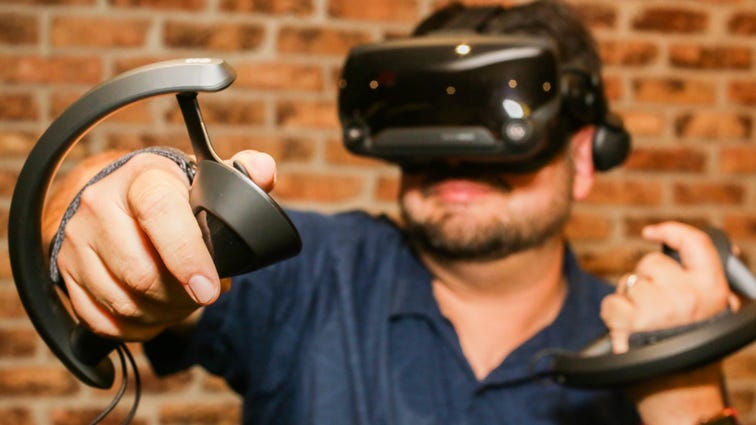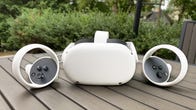Virtual reality tech has reached a fascinating transition point, with improvements in visuals, tracking and overall performance. The newly renamed Meta (formerly Facebook) has a new VR headset coming next year that will enable mixed reality and face tracking (but be more expensive), and Sony is releasing its PS5-connected PlayStation VR 2, which will have its own new controllers and possibly have eye-tracking. Apple is expected to have some sort of VR/AR headset by the end of next year, too, but what it will cost or do remains a mystery. Meanwhile, phone-connected headsets such as the HTC Vive Flow may start to pop up as well.
All that said, VR doesn’t have many practical business uses quite yet. Sure, VR technology is advancing rapidly, but right now, even the best VR headsets have their firmest foothold in the gaming market. That’s right, this incredible technology is currently best used to play video games. In fact, the Oculus Quest 2, which is an excellent home VR console, is one of my favorite places to play games.
If you’re a gamer looking to enter the VR space, the Quest 2 remains our top pick for best VR headset experience, especially with a recent increase in storage to 128GB on the $299 model, even though you need a Facebook account to use it. The Quest 2 also remains a strong entry point to VR that doesn’t look like it will become obsolete next year.
Even better is that VR games are the best they’ve ever been. We’ve been impressed by Valve’s VR masterpiece Half-Life: Alyx, Star Wars: Squadrons on PC, and plenty of Oculus Quest and PlayStation VR games, too. But you still have to decide whether you want a headset that plugs into your PC or console, or choose a standalone option like the Quest (which can double as a PC headset, too). The best VR headset for you really depends on your needs and your budget.

The Oculus Quest 2 is the best VR headset right now, but you may want another option if you have a PC or PlayStation 4/5.
Scott Stein/CNETThe world of VR tech is advancing, and more changes will come. Companies such as Qualcomm (which makes the chips inside most self-contained VR headsets, including the new Quest 2) are building new chips that point to a wave of better stand-alone headsets at lower prices — including ones that plug into your phone. The more expensive and business-targeted Vive Focus 3 shows where more premium standalone VR headsets could evolve.
Meanwhile, the mobile phone-based VR headset — like the Samsung Gear VR and Google Daydream — is basically dead. A good number of the current iPhone, Android and VR app options don’t even work with the old mobile VR goggles. If smartphone-based VR comes back, it will more likely be in the form of small headsets that plug into phones via USB-C for VR content, VR gaming and other uses.
If you’re a PC gamer, a solid gaming PC-connected VR headset offers the most versatile collection of software for an immersive VR experience and lets you use that headset for creative and business tools. Note that a more powerful VR system will still be largely tethered to a desktop or laptop and a PC VR headset may require external sensors, so they may not be the best option for everyone.
And what about console gaming? The aging PlayStation VR is still fun if it’s on sale and you have a PS4, mainly because there are loads more great VR game options for this device than you’d think. But keep in mind that the PlayStation 5, while it works with PSVR, needs the older PS4 controller and PS4 camera in order to work. You might want to wait for the next-gen PSVR 2 (which won’t be here this year).
Augmented- and mixed-reality headsets aren’t ready for everyday use yet, so a solid VR headset is your best bet for escaping to other worlds in the meantime. Read on to figure out which offers the best VR experience for you. We update this best VR headset list periodically, but note that prices are subject to change.

 \n ","topic":"","ttag":"","variant":"","viewguid":"","event":"listicle|image|1","correlationId":"","_destCat":"https:\/\/www.amazon.com\/Oculus-Quest-Advanced-All-One-Virtual\/dp\/B099VMT8VZ","productName":"Best standalone VR: Oculus Quest 2","formatType":"IMAGE","location":"LIST","position":1,"sku":"301-00351-01","dwLinkTag":"article-body|listicle|image","selector":"#article-body #listicle-11245104-2413-4405-ba8c-17d8391c8760 .itemImage"}}” rel=”noopener nofollow” target=”_blank”>
\n ","topic":"","ttag":"","variant":"","viewguid":"","event":"listicle|image|1","correlationId":"","_destCat":"https:\/\/www.amazon.com\/Oculus-Quest-Advanced-All-One-Virtual\/dp\/B099VMT8VZ","productName":"Best standalone VR: Oculus Quest 2","formatType":"IMAGE","location":"LIST","position":1,"sku":"301-00351-01","dwLinkTag":"article-body|listicle|image","selector":"#article-body #listicle-11245104-2413-4405-ba8c-17d8391c8760 .itemImage"}}” rel=”noopener nofollow” target=”_blank”>


Sarah Tew/CNET
Good: Self-contained and wireless; great touch controllers; comfortable design for gaming; doubles as PC VR headset
Bad: Requires Facebook account
At $299 with nothing else needed, the Oculus Quest 2 delivers virtual reality games and an immersive VR experience anywhere. This virtual reality headset is faster, smaller, cheaper and more comfortable to wear than the original Quest, but you have to log in to Facebook in order to use it. A new version of the Quest 2 doubles the storage of the $299 model to 128GB, and includes a silicone cover for the foam face piece after a voluntary recall of the foam covers earlier this year due to facial irritation concerns with a small subset of customers. Existing Quest 2 owners can order a free silicone cover.
The Quest 2 reminds me of the Nintendo Switch for its versatility and fun, plus it takes mere seconds to start up and fits really well over glasses. The standalone VR headset has self-contained motion tracking and a full-motion six degrees of freedom (aka 6DoF) VR controller that is the same as the ones on the PC-required Oculus Rift, plus a surprisingly great high-resolution display and built-in speakers. Apps are downloaded right to the standalone headset’s onboard storage. Its more limited mobile processor still plays games such as Beat Saber, Moss and SuperHot VR extremely well, and it can even connect with a PC if you want to, using a single USB-C cable.
Facebook discontinued the Oculus Rift S, so the Quest 2 is the best and only option over Oculus VR right now. But PC VR users have lots of other headset options.

 \n ","topic":"","ttag":"","variant":"","viewguid":"","event":"listicle|image|2","correlationId":"","_destCat":"https:\/\/www.hp.com\/us-en\/shop\/pdp\/hp-reverb-g2-virtual-reality-headset","productName":"Highest-resolution PC VR headset: HP Reverb G2","formatType":"IMAGE","location":"LIST","position":2,"sku":"","dwLinkTag":"article-body|listicle|image","selector":"#article-body #listicle-b2a48df4-eeee-457b-b97d-75b587c753b0 .itemImage"}}” rel=”noopener nofollow” target=”_blank”>
\n ","topic":"","ttag":"","variant":"","viewguid":"","event":"listicle|image|2","correlationId":"","_destCat":"https:\/\/www.hp.com\/us-en\/shop\/pdp\/hp-reverb-g2-virtual-reality-headset","productName":"Highest-resolution PC VR headset: HP Reverb G2","formatType":"IMAGE","location":"LIST","position":2,"sku":"","dwLinkTag":"article-body|listicle|image","selector":"#article-body #listicle-b2a48df4-eeee-457b-b97d-75b587c753b0 .itemImage"}}” rel=”noopener nofollow” target=”_blank”>


HP
The good: Really sharp high-res display, great audio, comfortable design
The bad: Mediocre controllers
If you’re looking for the best image quality in consumer VR, HP’s newest VR headset wins. For serious gamers (or VR racing sim fans), this VR technology may be your best choice. The 2,160×2,160-per-eye resolution and 114-degree field of view are the best at this price range, and the lightweight, comfy headset also has fantastic drop-down speakers designed by Valve. It’s technically a Microsoft Windows Mixed Reality headset that prefers to launch into Microsoft’s native Windows 10 VR ecosystem, but it bridges with Steam VR and works with those games and apps, too. Built-in camera-based room-tracking is easier to set up than the Valve Index’s external base stations, but is more prone to tracking errors. The included controllers, based on Microsoft’s VR controller design, feel clunkier than either the Oculus Touch controllers or Valve Index controllers. Also, the over-ear speakers are your only audio choice: there’s no headphone jack.

 \n ","topic":"","ttag":"","variant":"","viewguid":"","event":"listicle|image|3","correlationId":"","_destCat":"https:\/\/store.steampowered.com\/sub\/354231\/","productName":"Best PC VR to explore the future of VR controllers: Valve Index","formatType":"IMAGE","location":"LIST","position":3,"sku":"","dwLinkTag":"article-body|listicle|image","selector":"#article-body #listicle-abf80280-162e-4ac7-b8d6-b89363461b5b .itemImage"}}” rel=”noopener” target=”_blank”>
\n ","topic":"","ttag":"","variant":"","viewguid":"","event":"listicle|image|3","correlationId":"","_destCat":"https:\/\/store.steampowered.com\/sub\/354231\/","productName":"Best PC VR to explore the future of VR controllers: Valve Index","formatType":"IMAGE","location":"LIST","position":3,"sku":"","dwLinkTag":"article-body|listicle|image","selector":"#article-body #listicle-abf80280-162e-4ac7-b8d6-b89363461b5b .itemImage"}}” rel=”noopener” target=”_blank”>


Sarah Tew/CNET
Good: Amazing futuristic controllers; high-quality headset; works with Vive hardware
Bad: Expensive; requires room setup and tethering cable
Valve’s headset might be the most interesting PC virtual reality experience this year, just for its fancy new controllers. Valve’s “knuckle” controllers are pressure-sensitive and can track all five fingers, making them almost like gloves. Not many apps make the most of them yet, but Valve’s hardware is mix-and-match compatible with the HTC Vive, which also is built on the Steam VR platform. The Index headset has excellent audio and a really sharp, wide field-of-view display.
The Index uses external “lighthouse” boxes, meaning you need to set those up in a room first. It’s not as self-contained as Oculus’ Rift S, which can track the room with in-headset cameras, or the HTC Vive Cosmos. It’s also definitely not wireless, but if you already have some Vive hardware, you could add on parts of the Index to mix and match.

 \n ","topic":"Smartwatches","ttag":"amazon","variant":"","viewguid":"","event":"listicle|image|4","correlationId":"","assettitle":"","campaign":"amazon","cval":36,"leadCpc":0.36,"leadProdPrice":299.99,"manufacturer":"Sony","productName":"Sony PlayStation VR (Headset)","seriesGuid":"7c49de75-0891-4879-a28c-13e19868743a","sku":"5117500","reviewId":"c7b89f4d-40b1-4811-8f2f-27e018502e80","formatType":"IMAGE","location":"LIST","position":4,"dwLinkTag":"article-body|listicle|image","selector":"#article-body #listicle-e7d8e180-a522-4b64-baaa-f4ee3df55148 .itemImage"}}” rel=”noopener nofollow” target=”_blank”>
\n ","topic":"Smartwatches","ttag":"amazon","variant":"","viewguid":"","event":"listicle|image|4","correlationId":"","assettitle":"","campaign":"amazon","cval":36,"leadCpc":0.36,"leadProdPrice":299.99,"manufacturer":"Sony","productName":"Sony PlayStation VR (Headset)","seriesGuid":"7c49de75-0891-4879-a28c-13e19868743a","sku":"5117500","reviewId":"c7b89f4d-40b1-4811-8f2f-27e018502e80","formatType":"IMAGE","location":"LIST","position":4,"dwLinkTag":"article-body|listicle|image","selector":"#article-body #listicle-e7d8e180-a522-4b64-baaa-f4ee3df55148 .itemImage"}}” rel=”noopener nofollow” target=”_blank”>


Sarah Tew/CNET
Good: Plenty of games; lower price; works with many PS4 controllers like the DualShock and Move
Bad: Resolution isn’t cutting-edge; Sony hasn’t yet made great VR controllers that match the competition, but a new version may be coming next year
Sony’s years-old PSVR headset is still the only head-mounted display for gaming consoles and its screen still offers a surprisingly immersive experience. But Sony’s confirmed it’s working on a next-gen PSVR headset for the PS5, with a new set of controllers, that could be coming in 2022 if you want to wait. In the meantime, Sony has delivered — and continues to deliver — many excellent virtual reality games, many of them exclusives. All you need is the PSVR and a PlayStation 4 and you can start playing. (A few good games to start with are listed here.) This VR system is showing its age, though, compared to the alternatives. And, the new PS5, while it’ll work with the old PSVR, will need your old PS4 controllers and camera, plus a camera adapter, to work.
Note that this PlayStation VR headset is increasingly hard to get, so expect to pay a premium if you find it in stock anywhere.
VR FAQs
Should I wait to buy a VR headset?
There are a lot of expected headsets this year, as I mentioned above: Meta’s Project Cambria, PlayStation VR 2 and Apple’s mystery device. There are bound to be others. VR is a technology that’s still in flux, with companies aiming for products that are smaller and more able to be connected to devices like phones. It’s probably best to spend as little as possible to avoid investing in outdated gear. The Quest 2 is by far the best value, and it also happens to be the best-designed headset with the most upside at the moment, as long as you’re OK with the proposition of living under Meta’s metaverse umbrella and Facebook’s data policies.
What should I look for in a VR headset?
It depends, really, on whether you’re connecting to a PC or not… and whether you plan to do work with it. There are plenty of Windows-compatible headsets, but they vary in display resolution. Higher is better, and so is a larger field of view. Headsets can refresh at up to 120Hz now, and the faster they can refresh, the more natural and smooth VR movement feels. Most PC VR headsets have similar controller designs, and can bridge to work tools and apps. For portability or stand-alone comfort, the Quest 2 doesn’t have any competition right now (the Vive Focus 3 is business-targeted, and the Vive Flow is still too embryonic to recommend). For gamers with a game console, the PlayStation VR is the only option, but you’ll probably want to wait until 2022 for the PSVR 2 if you have a PS5. Also, consider the app libraries: Oculus has a lot of exclusive games, Windows-connected headsets have lots of compatibility with work apps and experimental tools, and Sony’s PlayStation library has unique VR games, too.
How do I care for my VR headset?
VR headsets can get dusty and grimy. Take extra care with the lenses, which should be cleaned gently with microfiber cloths the same way you’d treat glasses (don’t use liquids). It’s a good idea to invest in a silicone cover to protect the face plate from sweat and dirt, or look for extra face covers to swap out over time. It’s a very good idea to keep your headset covered when not in use. Take extra care not to expose your VR headset to bright sunlight: The sun can damage VR displays if beams hit the lenses of the headset. (To be safe, I keep mine in cases, or turn the lenses away from windows.)




